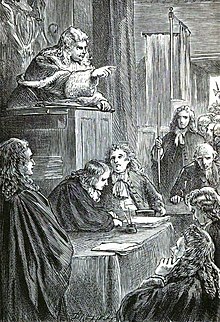Bloody Assizes

The Bloody Assizes were a series of
History
There were five judges:

Over 1,000 rebels were in prison awaiting the trials, which started in the Great Hall of Winchester Castle in Winchester on 26 August.[1] The first notable trial was that of an elderly gentlewoman named Dame Alice Lisle.[2] The jury reluctantly found her guilty and, the law recognising no distinction between principals and accessories in treason, she was sentenced to be burned. This was commuted to beheading, with the sentence being carried out in Winchester market-place on 2 September 1685.[1]
From Winchester the court proceeded through the West Country, and conducted a brief hearing in Salisbury, where there were no rebels to be tried for high treason, on 1 September 1685.[3] The court went on to the main centres of rebellion holding assizes at the Antelope Hotel in Dorchester on 5 September 1685, Exeter Guildhall on 14 September 1685 and the Great Hall of Taunton Castle on 17 September 1685, before finishing up at Wells Market and Assize Hall on 23 September 1685.[4] More than 1,400 prisoners were dealt with and although most were sentenced to death, fewer than 300 were hanged or hanged, drawn and quartered.[5][4] Of more than 500 prisoners brought before the court at Taunton between 17 and 19 September, 144 were hanged and their remains displayed around the county to ensure people understood the fate of those who rebelled against the king.[6]
Some 800–850 men were
Jeffreys returned to London after the Assizes to report to King James, who rewarded him by making him Lord Chancellor (at the age of only 40), 'For the many eminent and faithful services to the Crown'. Jeffreys became known as "the hanging judge".[7]
After the
Writing as recently as 1929, Sir John C. Fox[9] said:
Even to the present day, the mothers of West Somerset control their unruly offspring by threatening to send for 'Judge Jeffreys'.[10]
See also
References
- ^ ISBN 978-0-948251-00-9.
- ^ a b "The Bloody Assize". Somerset County Council. Archived from the original on 7 August 2011. Retrieved 17 December 2015.
- ^ "An account of the Salisbury Assize Court of Lord Chief Justice Jeffrey". Life and Times of the Duke of Monmouth. 1 September 1685. Retrieved 6 December 2020.
- ^ a b "The Bloody Assize". Somerset County Council. Archived from the original on 7 August 2011. Retrieved 21 October 2012.
- ^ "The battle of Sedgemoor". Britain Express. Retrieved 21 November 2007.
- ^ "Taunton Castle". Everything Exmoor. Archived from the original on 5 May 2008. Retrieved 21 November 2007.
- ^ a b c "George Jeffreys (1645–1689)". Early Modern Notes. Retrieved 20 February 2008.
- ^ "The Bloody Assizes". From Watford Gap to Camelot. Retrieved 20 February 2008.
- ^ Fox was Vice-Chairman of Oxfordshire Quarter Sessions and had been Senior Chancery Master of the Supreme Court.
- ^ Sir John Fox, The Lady Ivie's Trial, (Oxford University Press, 1929), xlix.
Further reading
- The Bloody Assize Archived 7 August 2011 at the Wayback Machine, web site of Somerset County Council
